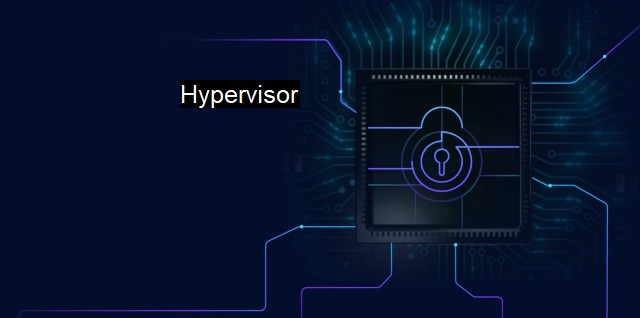What is Hypervisor?
The Impact of Hypervisors on Virtualization and Cybersecurity: Understanding Type 1 and Type 2 Hypervisors for Safe and Secure Data Storage
A hypervisor, also known as Virtual Machine Monitor (VMM), is a significant concept in the field of cybersecurity which plays an essential role in managing and providing the resource allocation for the virtual machines. As cybercrime becomes more sophisticated and pervasive, the hypervisor takes on greater significance for its function in overall cybersecurity management.Principally, a hypervisor is a kind of software, firmware or hardware that generates and runs virtual machines. It serves as the platform for a host machine to operate multiple virtual machines by sharing its resources such as memory and processing. It abstracts the operating system and applications from the physical hardware, facilitating smooth running of multiple Operating System (OS) on a single physical system. Hence, this graphical instance creates an isolated environment that affords excellent flexibility and control over the system’s security.
There are primarily two types of hypervisors. The Type 1, also known as the bare metal, runs directly on the host machine’s hardware. It can directly control the hardware resources and manage the guest operating systems. Type 2 hypervisor, on the other hand, is hosted on an operating system and cannot access the physical machine’s resources directly. It routes the resource requests from virtual machines through the host operating system.
The hypervisor has various key impacts on cybersecurity. By creating separate virtual machines, it minimizes the chances of successful cyber-attacks. If one virtual machine fell victim to a cyber-attack, the malware would be confined within that particular machine, leaving the other machines unaffected. In other words, it is akin to the concept of quarantining, thus making the hypervisor an active participant of the computer’s security mechanism in confined and controlled settings.
The segregation provided by a hypervisor allows for extensive and effective testing of suspicious code or malicious software (malware). In a segregated environment, malicious software can be safely tested and observed for understanding their behavior without any risk to the system. Also, the hypervisor's capabilities in running various OS simultaneously can facilitate a diverse security system.
The role of hypervisors in antivirus systems is also worth noting. Given that virtual machines can be monitored separately, this allows for efficient threat detection and elimination. If one virtual machine gets infected by a virus, the antivirus software detects and isolates the threat, restricting it from threatening the overall system’s health.
In the context of cloud computing, the balance between security valuation and performance is of utmost importance. A hypervisor posture, whether Type 1 or Type 2, its deployment, and patch management are significant points to consider in the optimization of these aspects. Security attacks on various layers like Hypervisor, Virtual Machine, and Cloud Data need proactive mitigation strategies where Hypervisor resumes strategic core positioning.
Despite the features and capability of hypervisors, they are, like any software or hardware, not immune from vulnerabilities. attacks like Venom and Cloudburst have exposed the vulnerability of hypervisors. Therefore, it is imperative to configure hypervisor efficiently and update it regularly to ensure the virtual environment's overall security.
a hypervisor, as a virtualization tool, plays a pivotal role in cybersecurity and antivirus strategies. While it is not the panacea for all cybersecurity issues, it helps to contain threats, efficiently manage system resources and thereby add a robust layer of protection. as with any system, it requires regular updates and diligent management to safeguard a system from potent threats. This accentuates the significance of hypervisor within the context of cybersecurity and antivirus mechanisms.

Hypervisor FAQs
What is a hypervisor?
A hypervisor is a software that creates and manages virtual machines (VMs), which enables multiple operating systems to run on a single physical machine without interfering with each other.What is the importance of hypervisors in cybersecurity?
Hypervisors are crucial in cybersecurity, as they provide a layer of isolation between different systems, preventing viruses and other malware from affecting multiple virtual machines or the host operating system.Are hypervisors immune to cyber attacks?
No, hypervisors are not immune to cyber attacks. Attackers can exploit vulnerabilities in the hypervisor itself or VMs running on the hypervisor. It is important to secure the hypervisor and VMs by applying security patches, using firewalls, and implementing access control policies.How can hypervisors be used in antivirus software?
Antivirus software can leverage hypervisors to create a safe environment to analyze files and websites for malicious activity. By running potentially harmful code in a virtual machine, antivirus software can protect the host system from infection.| | A | | | B | | | C | | | D | | | E | | | F | | | G | | | H | | | I | | | J | | | K | | | L | | | M | |
| | N | | | O | | | P | | | Q | | | R | | | S | | | T | | | U | | | V | | | W | | | X | | | Y | | | Z | |
| | 1 | | | 2 | | | 3 | | | 4 | | | 7 | | | 8 | | |||||||